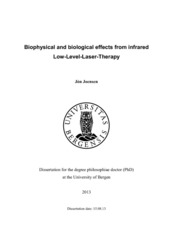| dc.contributor.author | Joensen, Jon | en_US |
| dc.date.accessioned | 2013-10-30T14:43:43Z | |
| dc.date.available | 2013-10-30T14:43:43Z | |
| dc.date.issued | 2013-08-15 | eng |
| dc.identifier.isbn | 978-82-308-2345-3 | en_US |
| dc.identifier.uri | https://hdl.handle.net/1956/7461 | |
| dc.description.abstract | Introduction: Physiotherapists have since the early days of the profession utilized electro physical agents (EPAs) as part of their intervention toolbox. A prerequisite for application of all EPAs is that the applied energy affects biological processes in the body tissue. Low level laser therapy (LLLT) has been used as an intervention for the last three decades to modulate processes in pathological tissue beneath the skin. However, the photoprotective property of the skin is a significant barrier to optical energy applied by LLLT devices. The irradiated electromagnetic energy from LLLT first interacts with the skin where biophysical processes occur. The penetrating part of the energy will then act as an active ingredient in biological processes in subcutaneous tissue. Aim: The overall aim of this Thesis was to investigate biophysical and biological effects from commercial infrared LLLT devices commonly used in clinical physiotherapy practice. Methods: Study I was designed as a blinded placebo-controlled study of repeated measures. The thermal effects from different doses of irradiation from two infrared class 3B lasers was investigated in situ in human skin of different skin colours, age and genders. Study II was a basic research study of repeated measures design. The time-profile for energy penetration through skin during 150 sec of irradiation from two infrared class 3B lasers was elucidated in vivo in rat skin. Study III was designed as a double-blind randomized controlled trial on effect from a 3 J irradiation dose in situ/in vivo in acute rat Achilles tendons trauma. Results: There was a positive correlation between increasing irradiation doses and increased skin temperature for both lasers in all groups of participants. The skin temperature increased significantly (p<0.01) more in dark skin during laser irradiation than in light skin, regardless of irradiated doses and laser type. There were no significant differences in skin temperature between genders or age groups during laser irradiation. The percentage of energy penetrating through rat skin from the λ=810 nm laser was constant (20%) during 150 seconds of exposure, while skin penetration from the λ=904 nm laser increased almost linearly (38%-58%) and by 50% during the 150 sec of irradiation. The percentage of energy penetrating through rat skin during irradiation was significantly (p<0.01) higher from the λ=904 nm laser than from the λ=810 nm laser at all measured time-points. The biological effect from 3 J half an hour after trauma was significant (p<0.05) increased tendon thickness (including the peritendon) in injured Achilles tendons compared to animal’s healthy Achilles tendon in the active-LLLT group. These tendon thickness differences were insignificant (p=0.35) in the placebo-LLLT group. There were no significant differences in UTS in any group. Conclusions: This project has revealed that the biophysical properties of two common types of LLLT devices; λ=810 nm and λ=904 nm, yield significantly different thermal effects in human skin and possess significant different optical penetration abilities in rat skin. These biophysical properties of infrared class 3B lasers are of scientific value as no studies so far have dealt with these effects. These findings support the differentiation made in WALT dosage recommendations for these two types of lasers. The thermal effects in light and medium coloured skin were negligible (<1.5°C) for WALT recommended doses from both laser types, so were the thermal effects in dark skin from the λ=904 nm, 60 mW MOP laser (<2°C). In contrast, the λ=810 nm, 200 mW caused thermal effects (<9°C) above the pain threshold, and indicate that these LLLT devices parameters are probably unsuitable for clinical use in patients with dark skin. The project also revealed that LLLT irradiation can exacerbate the acute inflammatory process in terms of increased oedema formation. Possible explanations for this somewhat surprising finding include that half an hour may be too early to initiate LLLT after trauma, or that a recently LLLT-treated injured tendon may be more vulnerable than untreated tendons to a repeated injury, or simply that the dose was too high. Future studies are needed to determine these issues. | en_US |
| dc.language.iso | eng | eng |
| dc.publisher | The University of Bergen | eng |
| dc.relation.haspart | Paper I: Joensen J, Demmink JH, Johnson MI, Iversen VV, Lopes-Martins RAB and Bjordal JM. The Thermal Effects of Therapeutic Lasers with 810 and 904 nm Wavelengths on Human Skin. Photomedicine and Laser Surgery (2011) Vol.29, No.3, pp.145-153. The article is available at: <a href="http://hdl.handle.net/1956/7459" target="blank">http://hdl.handle.net/1956/7459</a> | en_US |
| dc.relation.haspart | Paper II: Joensen J, Øvsthus K, Reed RK, Hummelsund S, Iversen VV, Lopes-Martins RAB and Bjordal JM. Skin Penetration Time-Profiles for Continuous 810 nm and Superpulsed 904 nm Lasers in a Rat Model. Photomedicine and Laser Surgery (2012) Vol. 30, No. 12, pp. 688-694. The article is available at: <a href="http://hdl.handle.net/1956/7460" target="blank">http://hdl.handle.net/1956/7460</a> | en_US |
| dc.relation.haspart | Paper III: Joensen J, Gjerdet NR, Hummelsund S, Iversen VV, Lopes-Martins RAB and Bjordal JM. An experimental study of low-level laser therapy in rat Achilles tendon Injury. Laser in Medical Science (2012) Vol. 27, No. 1, pp.103-111. The article is available at: <a href="http://hdl.handle.net/1956/5442" target="blank">http://hdl.handle.net/1956/5442</a> | en_US |
| dc.title | Biophysical and biological effects from infrared Low-Level-Laser-Therapy | en_US |
| dc.type | Doctoral thesis | |
| dc.rights.holder | Copyright the author. All rights reserved | |
